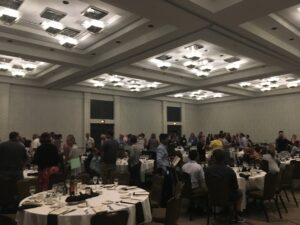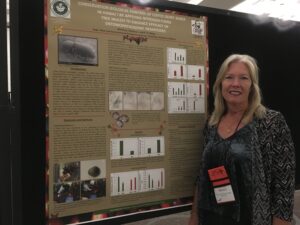Final report for GW18-104
Project Information
Coffee (Coffea arabica) is a high-value commodity, and especially so in Hawaii. Coffee production and sustainability are adversely affected by the Coffee berry borer (CBB), Hypothenemus hampei, as it can cause more than 35% yield loss. Current management practices for CBB include labor-intensive field sanitation and multiple applications of the biopesticide Beauveria bassiana. This project sought to develop sustainable CBB management strategies through a conservation biological control approach that enhanced cosmopolitan soil-dwelling entomopathogenic nematodes (EPN). As soil-dwelling organisms, EPN do not have good mechanisms to protect agains desiccation or UV radiation. These factors limit EPN utility in sustainable IPM practices. However, mulching the soil under the coffee canopy where coffee cherries infected with CBB fall can address these limitations and enhance the efficacy of EPN aginst CBB. Leucaena leucocephala hybrid KX2 or KX4 is a fast-growing nitrogen-fixing tree locally available to farmers, and its chipped mulch is an ideal mulching material for coffee production. Two field trials were conducted to evaluate if Leucaena mulch enhances parasitism of indigenous EPNs on CBB and reduces CBB pressure in the coffee orchard.
Mulching with Leucaena leucocephala KX2/KX4 increased EPN infection of CBB by 1.5 to 2.8 fold in field trails. Inundative release of lab-reared EPN did not increase EPN infection of CBB, regardless if mulch was present or not. Although overall infection of CBB by EPN was 10-23%, mulching may enhance CBB control and aid farmers in reducing fertilizer inputs, as well as improving soil health, which will lead to yield and profitability increases.
The goal of the project was to manage Coffee Berry Borer using entomotatogenic nematodes. The specific objectives were to:
- Identify indigenous EPN species recovered from coffee orchards on Oahu, Hawaii;
- Compare virulence of indigenous EPN strains to Steinernema feltiae and Oscheius tipulae on CBB;
- Evaluate the efficacy of Leucaena mulch on enhancing EPN infection of CBB; and
- Examine the effects of Leucaena mulch on coffee plant and orchard soil health.
Cooperators
Research
Objective 1: Identify indigenous EPN species recovered from coffee orchards on the island of Oahu, Hawaii.
Soil was collected from coffee fields at Poamoho Experiment Station in Waialua, and Dole Waialua Estates Coffee in Haleiwa, Oahu, and baited with mealworm larvae. Entomopathogenic nematodes (EPNs) recovered from mealworms using White traps and maintain in water. Isolates were amplified using Polymerase Chain Reaction (PCR) with universal ITS primers and sequenced. The sequences were matched to those in the NCBI GeneBank using a Blast search.
Objective 2: Comparing virulence of indigenous EPN strains to Steinernema feltiae on CBB.
The indigenous EPN species Heterorhabditis H1, Heterorhabditis indica, and Oscheius tipulae isolated from experimental sites or elsewhere from Hawaii were compared to the nonindigenous EPN Steinernema feltiae. In general, CBB larvae were more susceptible to EPN infection than the adult CBB. Steinernema feltiae had the highest infection of CBB larvae (15%) among the EPN species tested. Heterorhabditis H1 was the only EPN to infect adult CBB, although the infection rate was low (5%). No other EPN isolates infected adult CBB.
Objective 3: Evaluate efficacy of N-fixing Leucaena mulch on enhancing infectivity of indigenous EPNs against CBB using augmentative and conservative biological control methods.
A 2×2 factorial designed experiment was conducted at Poamoho Experiment Station. The soil surface under the canopy of coffee trees was 1) mulched (M) or not mulched (NM) with Leucaena lucocephala KX2, and 2) drenched or not drenched with Heterorhabditis H1 at 31,000 EPN/ft2. Each treatment had 3 replications. Heterorhabditis H1 inoculum was obtained from Poamoho soil, reared on mealworm larvae in the laboratory, and drenched into the coffee plots with 1 Liter of water using a watering can. EPN infection rate on CBB over time was monitored using field cages made of a 80-mesh strainer (Kleen-Rite Corp, Columbia, PA) where 5 coffee cherries naturally infested with CBB were enclosed in the field cage, buried into each plot for one week. Samples were taken biweekly over 3 months. Experiments were repeated but only with M vs NM treatments once at Poamoho (Fall 2017), and another one at Dole Plantation (Fall 2018). The experiment at Dole only lasted for 2 months but had 6 replications.
Objective 4: Examine the effects of Leucaena mulch treatments on plant and soil health.
During the Dole field trial, stem diameter and chlorophyll content of three branches per tree were monitored for plant health as affected by mulching. Soil samples were also taken before initiation of mulching and at 2 months after mulching to determine the effects of mulching soil health. A total of 6 trees per treatments were monitored.
The seven EPN isolates recovered from Poamoho were identified to Heterorhabditis sp. SGgi, Heterorhabditis sp. H1, and Oscheius sp. The four 4 EPN isolates recovered from Dole were all identified as Oscheius sp. CBB larvae are more susceptible to EPN infection than the adult stage. Since CBB larvae are only present inside the coffee cherries, EPN biocontrol agents need to be delivered into the cherries to provide effective control. However, the adult CBB moves in and out of the cherries searching for new cherries inwhich to lay eggs. None-the-less, some EPNs manage to infect the adult stage which explained recovery of EPN infection on CBB larvae or adults inside the cherries in the field cages of Objective 3.
While it is encouraging to see that mulch had a greater percentage of CBB infected with EPN than no mulch (P ≤ 0.05), the inundative (augmentative) approach of introducing indigenous EPNs by drenching laborayory reared EPNs did not improve EPN infection. Soil moisture seems to play a role in enhancing EPN infection by mulching. We also observed more fungal infection on CBB in no mulch samples than mulched treatment. However, these fungi were not identified. It is unclear if these are saprophytic fungi or entomopathogenic fungi.
When data wwere compared between Poamoho vs Dole trials, mortality of CBB in Leuceana mulch was greater at Poamoho than at Dole. This could be due to the present of Heterorhabditis sp. at Poamoho but not at Dole. Objective 2 suggested that the Heterorhabditis strains are more virulent than the Oscheius sp.
Leuceana mulch increased stem diameter by 1.13% (P ≤ 0.05) and showed a trend of increasing canopy coverage by 2% monitored by %Cover© app. Though minimal, this improvement was observed within a short 2 months after mulching. We will ask the farmer to let us continue to monitor the effect over a longer term.
Based on nematode community analysis as soil health indicators, mulch improved the soil food web structure with a significant increase in abundance of bacterivores, fungivores, and omnivores nematodes. Predatory nematode abundance was also increased though not significantly. What was most impressive was the dramatic increase of EPNs (P ≤ 0.01) from 13 to 780 EPNs/250 cm3 soil. Mulching with Leucaena lucocephala KX2 or KX4 can improve soil health and indigenous EPN abundance in a short period of time. Future research is need to improve EPN infectivity on CBB.
Research outcomes
Education and Outreach
Participation summary:


A poster was created and presented at the Society of Nematologists 57th annual meeting in Albuquerque, NM on July 21-25, where nematologists and related professionals attended for an educational conference. My poster title was "Conservation biological control of coffee berry borer in Hawai`i by applying nitrogen fixing tree mulch to enhance the efficacy of entomopathogenic nematodes." I presented the details of my project and the results of my project to date.
A paper is being drafted for publication as the College of Tropical Agriculture and Human Resources (CTAHR) Extension sheet (http://www.ctahr.hawaii.edu/site/Info.aspx).